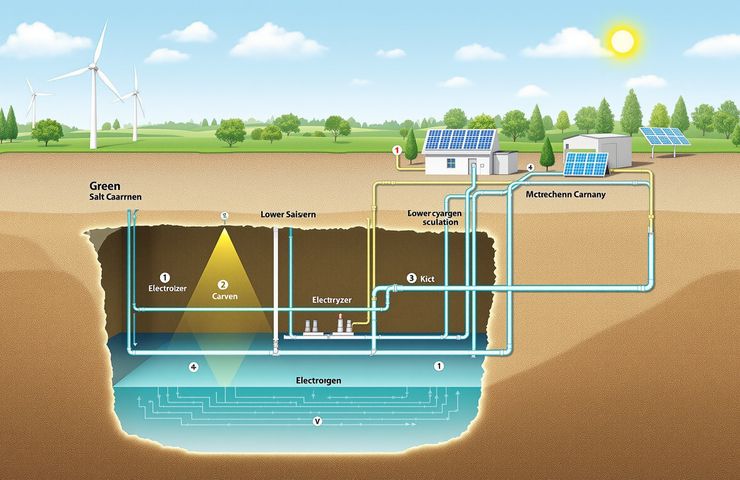
Green Hydrogen Storage Steps Up: Plug Power Delivers 44.5 Tons to Germany’s H2CAST Cavern
October 22, 2025Picture this: vast underground salt caverns working like giant sponges—not for rainwater, but for Europe’s most versatile fuel. That vision has moved off the drawing board when Plug Power delivered 44.5 metric tons of green hydrogen to the pilot H2CAST site in Lower Saxony, Germany.
It wasn’t a solo effort. U.S.-based fuel cell pioneer Plug Power teamed up with Dutch gas network heavyweight Gasunie and German cavern operator STORAG ETZEL. Together, they’re seeing if these repurposed underground salt caverns can safely stash huge volumes of renewable hydrogen, helping to smooth out the highs and lows of wind and solar power across Europe.
Green Hydrogen Production via Electrolysis
It all starts at Plug Power’s electrolyzer facility in Werlte, where water splits into hydrogen and oxygen using clean electricity. By timing production to peak wind and solar hours, they keep the carbon footprint as close to zero as possible. That’s electrolysis in action: on-demand, zero-emission hydrogen that scales with Europe’s renewable capacity.
Repurposing Salt Caverns for Hydrogen Storage
Salt caverns have decades of experience holding natural gas—they’re impermeable and geologically rock-solid. The H2CAST initiative, led by Gasunie and backed by STORAG ETZEL, aims to prove these caverns can do the same for hydrogen. Pump it in when supply is high, pull it out when demand spikes—offering seasonal and intraday balancing that batteries alone can’t match.
Strategic Impact and Next Steps
This first delivery isn’t just a logistics win; it’s a landmark moment on the way to a Europe-wide hydrogen storage network. Germany’s energy transition needs flexible buffers to absorb more renewables, and cavern storage could be the backbone. After phase one’s success, Plug Power signed on to send another 35 metric tons of green hydrogen to H2CAST, signaling they’re ready to scale up.
Sure, cost and regulatory hurdles remain, but this partnership shows the technical foundation is solid. As EU policymakers push for a robust hydrogen market, projects like H2CAST will shape safety standards, speed up permitting, and drive storage costs down over time.
Plug Power and the Road Ahead
Founded in 1997 and trading as PLUG on NASDAQ, Plug Power has grown from niche fuel cell systems into a global green hydrogen powerhouse. Their European expansion reflects a bigger strategy: pairing next-gen fuel cell technology with renewable hydrogen production and delivery to decarbonize heavy industry, logistics, and power grids.
Lower Saxony’s Energy Evolution
Lower Saxony, with its industrial heartland and decades of underground gas storage know-how, is the perfect proving ground. The Etzel salt caverns have stored natural gas safely for years; now they’re front and center in Germany’s bid to lead Europe’s shift to a zero-emission energy system.
Looking ahead, if H2CAST hits its stride, we could unlock hundreds of thousands of cubic meters for renewable hydrogen buffer capacity, offering a blueprint for similar projects across the continent. It’s a vivid reminder: mix clean hydrogen, geological expertise, and cross-border teamwork—and you’re not just building infrastructure, you’re forging resilience for a cleaner future.



 With over 15 years of reporting hydrogen news, we are your premier source for the latest updates and insights in hydrogen and renewable energy.
With over 15 years of reporting hydrogen news, we are your premier source for the latest updates and insights in hydrogen and renewable energy.